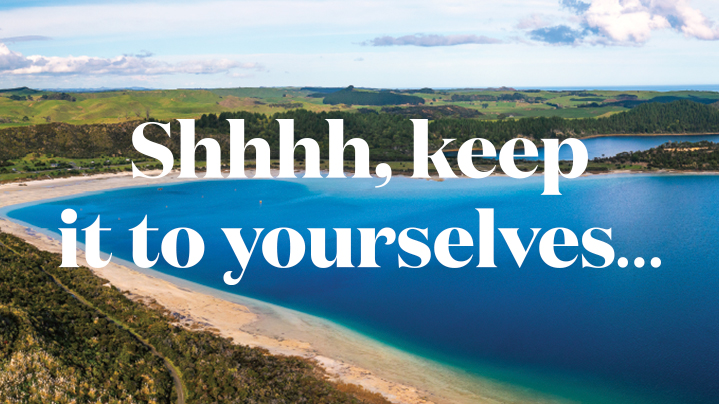Shhhh, keep it to yourselves...
With international travel off the cards, Bayleys takes a look at some New Zealand destinations that are found along roads less travelled and warns, they’re so good, you might want to keep them on the down-low…
Kai Iwi Lakes, Northland
It’s where family summer memories can be made and treasured.
Kai Iwi Lakes, located north of Dargaville off State Highway 12 and just three hours’ drive from Auckland, is made up of three freshwater basin-type dune lakes that were formed over time by the accumulation of rainwater in depressions of sand.
Lakes Taharoa and Waikere are the deepest known dune lakes in New Zealand with maximum depths of around 37 and 30 metres, respectively, while Lake Kai Iwi is considerably shallower with a maximum recorded depth of 16 metres.
Pine Beach, at Lake Taharoa, has tropical island vibes with its clear water and white sand – perfect for swimming and kayaking and for children to paddle. Trout fishing enthusiasts will also be keen to try their luck.
There are two campgrounds located on the lake’s foreshore, both suitable for tents, caravans or motorhomes.
You can opt for family-friendly Pine Beach at the eastern end where there are powered and non-powered sites along with good amenities, or Promenade Point where there’s no power or hot showers but tranquillity in spades.
Explore the area via the many walking and cycling tracks around the lakes and appreciate the proactive native wildlife and revegetation programmes that are in place to enhance the wider recreational reserve.
Kaitoke Hot Springs, Great Barrier Island
Get away from it all on Great Barrier Island, a 30-minute flight or 4.5-hour ferry journey away from Auckland and while you’re there, soothe the worries of the world with a soak in the Kaitoke Hot Springs.
These are not your stereotypical hot pools with tiled surrounds and changing rooms – they’re natural hot springs in a bush setting with no bells and whistles and for that reason, extra special.
A tangible reminder of the Auckland region’s volcanic history, these hot springs are straight from the source and will not be crystal clear, however this is back-to-nature dipping.
You’ll have to earn your warm bath with an easy wheelchair and pram-friendly 45-minute walk from the Whangaparapara Road entrance, before you can hop in the waters.
The well-maintained track follows the shoreline, traverses the Kaitoke wetlands and winds its way through regenerating kānuka forest.
The main pool is pretty warm, and you’ll need to take care getting in and out of the water as it can be slippery at times.
Local intel suggests that the smaller pools upstream, further along the path, can vary a bit in temperature so you can be like Goldilocks until you find one that is “just right”.
Entrance to the hot springs is free, and there’s a long-drop facility, but no other amenities, so be prepared.
Lake Rotomairewhenua (Blue Lake), Nelson Lakes National Park
Lake Rotomairewhenua means the “lake of peaceful lands” and can be found in the alpine wilderness of the Nelson Lakes National Park conservation area.
It takes some planning to visit, with your best bet being a multi-day hike from the alpine village of St Arnaud, or you can get dropped off a little closer via water taxi from the Lake Rotoroa jetty.
Scientific tests carried out in 2011 by New Zealand’s National Institute of Water and Atmospheric Research (NIWA) showed Lake Rotomairewhenua – better-known as Blue Lake – to be the clearest natural body of fresh water on earth.
With visibility up to 80 metres – close to that of distilled water – and located at 1,200 metres above sea level, the spring-fed source of the water lies just below the tree line of stunted mountain beech, hence Blue Lake is perpetually hovering between five and eight-degrees Celsius.
The blue-violet coloured waters of Lake Rotomairewhenua are sacred to Māori, with particular cultural significance for local iwi Ngāti Apa ki te Rā Tō, who ask that visitors respect these waters and do not wash themselves, clothes, or dishes in the lake.
Visitors to Lake Rotomairewhenua often describe it as being “ethereal” with one hiker noting in the DoC hut’s log book “no words”.
Lake Quill, Fiordland National Park
In a steep, high altitude basin of the Fiordland National Park and famed for feeding the iconic Sutherland Falls, Lake Quill has remoteness and big screen status on its side.
Lake Quill can be viewed from Mackinnon Pass on the Milford Track, but if you’re not about to lace up your boots, you’ll need to book a helicopter flight to get the best look-see at the “hanging lake”.
And you won’t be the only ones taking flight in this part of the world - the endangered kea, the globe’s only true alpine parrot, frequents the area.
It’s one of the country’s ultimate scene-stealing vistas, with the director of the 2018-released Tom Cruise movie Mission: Impossible – Fallout choosing to shoot some of the movie’s action scenes, including a helicopter gun fight, around Lake Quill.
One of the highest waterfalls in the country, the spectacular three-tiered Sutherland Falls which tumble into Milford Sound, are also visible in the background of the eagle scene in Peter Jackson’s fantasy film The Hobbit.
Lake Quill is so-named for early surveyor and explorer William Quill, who discovered this alpine gem. According to history, the intrepid adventurer scaled the side of the “great Sutherland waterfall” and it is “unclear whether anyone has repeated his ascent”.
Read more...
[Download PDF]